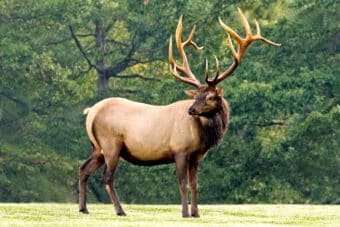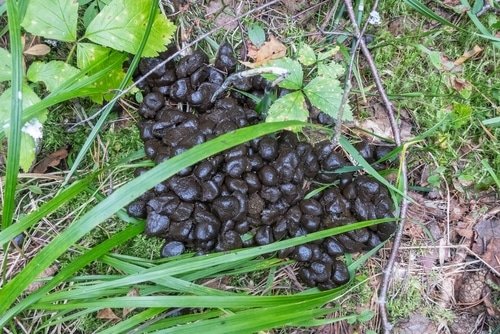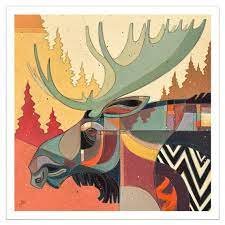When it comes to the majestic creatures that roam the wild, few animals capture our imagination, like the moose vs. elk. These magnificent creatures have long fascinated nature enthusiasts, hunters, and wildlife lovers.
Both moose and elk belong to the deer family, but they are distinct species with significant differences in appearance, behavior, habitat preferences, and even dietary choices.
A Tale of Two Giants
Imagine standing amidst towering trees in a secluded forest. In this wilderness realm, two giants reign supreme: the moose and the elk.
These colossal herbivores possess an undeniable allure that captivates our attention and fuels our curiosity. Yet, it is crucial to recognize that beneath their shared classification lies a world of differences waiting to be explored.
The Significance of Knowing Their Differences
Understanding the disparities between these noble creatures goes beyond mere trivia; it grants us a deeper appreciation for nature’s diversity. Recognizing the contrasting attributes of moose and elk enables us better to comprehend their unique ecological roles and conservational needs.
Moreover, distinguishing between these two species can prevent misunderstandings or misidentifications when discussing or observing them in their natural habitats. Whether you’re an aspiring naturalist or an avid outdoors enthusiast who seeks encounters with these majestic beings, knowing how to differentiate between moose and elk is indispensable.
In this article, we embark on an enlightening journey into comparing moose and elk – uncovering their physical traits, preferred environments, behavioral patterns, and dietary preferences – while also considering their conservation status. By delving into these topics meticulously, we aim to unravel the fascinating tapestry woven by nature’s artistry.
Moose – Majestic Giants of the North

When it comes to size, moose are undeniably impressive creatures. Towering over their elk counterparts, adult moose can reach heights of up to seven feet at the shoulder, making them one of the tallest land mammals in North America. In terms of weight, a fully grown male moose can tip the scales at a hefty 1,500 pounds!
Comparatively, elk tend to be slightly smaller in stature and weigh around 700 to 1,100 pounds on average. With these significant disparities in size and weight between moose and elk, it’s clear that moose truly embody an aura of grandeur.
Prominent Features: Antlers, Hump, Long Legs
One cannot discuss moose without mentioning their enchanting antlers. These impressive appendages give male moose an air of regality during the rutting season as they compete for mates. Unlike elk antlers that branch forward with multiple tines, moose antlers are broad and palmate—resembling outstretched hands with smooth paddles at the ends.
Another distinguishing feature is the characteristic hump on their shoulders which adds to their majestic appearance. Additionally, long legs help these magnificent creatures navigate through various terrains efficiently.
Habitat and Distribution
Moose have a diverse habitat preference that reflects their adaptability across different regions. They thrive in boreal forests with dense vegetation for cover and food sources such as willows and birch trees. Wetlands also attract them due to abundant aquatic plants like water lilies—a delightful treat for these herbivorous giants.
Interestingly, moose have managed to conquer lands on three continents—North America, Europe (including Scandinavia), and Asia (including Siberia). Their wide range speaks volumes about their remarkable ability to adapt and survive in various ecosystems across the globe.
With the physical characteristics of moose thoroughly explored, we can now move on to unraveling the fascinating aspects of elk. Prepare to be captivated by the distinct traits and habitats that set them apart from their majestic moose counterparts.
Elk – Physical Characteristics

When comparing the physical characteristics of moose and elk, one of the most noticeable differences is their size and weight. Elk are generally smaller and lighter than their moose counterparts.
While a fully mature bull moose can reach towering heights of up to 7 feet at the shoulder and weigh anywhere between 1,200 to 1,600 pounds, mature male elk usually stand around 5 feet tall at the shoulder and weigh between 700 to 1,000 pounds. Additionally, elk possess strikingly large antlers that can span up to six feet from tip to tip.
These majestic antlers are often adorned with multiple branches or points, making them a remarkable sight in nature. In terms of body build, elks have a more slender physique compared to the bulkier moose.
Habitat and Distribution
Elk thrive in diverse habitats such as open woodlands, grasslands, and meadows. These adaptable creatures can be found throughout North America in various regions including the Rocky Mountains, Pacific Northwest, Great Plains, and even parts of eastern Canada. They also have a significant presence in countries like Russia, Mongolia, China’s Manchuria region (northeast), as well as Kazakhstan in Asia.
However, they are absent from areas with dense forests or dense vegetation where their sizeable antlers could become cumbersome. In these open habitats rich with vegetation suitable for grazing purposes, elk have carved out their niche as skilled herbivores who primarily feed on grasses found in meadows and open woodland areas.
This distinct preference for open environments sets them apart from their larger cousins – the moose – who tend to favor wetlands or boreal forests with ample water sources. It is remarkable how nature has bestowed each species with unique adaptations that allow them to flourish within specific ecosystems while being distinguished by their differences.
Behavior and Social Structure
Moose Behavior
Moose, these majestic creatures of the northern wilderness, have some fascinating behavioral patterns. During the rutting season, which typically occurs in late summer or early fall, male moose engage in intense battles to establish dominance and win over potential mates.
These clashes are not for the faint-hearted, as these magnificent beasts will lock antlers and push with all their might. The sound of clashing antlers echoes through the forests as they compete for supremacy.
Outside of rutting season, moose tend to be solitary creatures. They prefer solitude while they go about their daily business of foraging and exploring their vast home ranges.
However, during mating season or when accompanied by their offspring (called calves), moose can exhibit some social behavior. Mothers may fiercely protect their young ones from potential threats, forming temporary associations until the calves are old enough to venture on their own.
Elk Behavior
Elk are known for their striking bugling calls that resonate across mountains and plains during the mating season. These haunting vocalizations serve a dual purpose: attracting potential mates and asserting dominance over competing males. The bugle is a unique sound that combines both high-pitched whistles and deep guttural tones – an awe-inspiring symphony of nature.
Unlike moose, elk have a more complex social structure based around herds or groups called harems. Dominant males gather a group of females (cows) known as a harem that they guard fervently against rival suitors.
It’s fascinating to observe these herds grazing harmoniously together while maintaining a strict hierarchy within the group. While both moose and elk exhibit intriguing mating rituals to attract mates, there are notable differences in how they interact socially.
Moose tend to be solitary animals outside of breeding season whereas elk demonstrate highly structured herding behavior within their harems. These behavioral disparities contribute to the unique charm and allure of these magnificent creatures of the wild.
Dietary Preferences
Moose Diet: Prefer browsing on leaves from trees or shrubs
When it comes to food, moose are quite picky eaters. These majestic creatures have a particular fondness for browsing on the tender leaves of trees and shrubs.
They use their long, agile legs to reach high branches, often standing on their hind legs like nature’s own tree surgeons. Moose have a knack for reaching foliage that many other animals can’t access, allowing them to munch on delectable treats that grow out of reach for most herbivores.
This selective diet provides moose with an abundance of nutrients and energy. Notably, moose also have a unique affinity for aquatic plants such as water lilies.
These gentle giants are excellent swimmers and aren’t afraid to dive into shallow lakes or ponds to snatch up mouthfuls of these aquatic delights. It’s quite a sight to witness these massive creatures gracefully maneuvering through the water, their heads adorned with floating lily pads as they savor this unusual addition to their menu.
Elk Diet: Graze on grasses in open areas
While moose delicately nibble on vegetation found up high, elk take a different approach when it comes to satisfying their hunger pangs. Grazing is the name of the game for these magnificent animals. Elk prefer open areas where they can happily chow down on an array of grasses that carpet the ground beneath them.
The meadows and grasslands serve as natural dining rooms for elk as they traverse these expansive spaces in search of the tastiest blades of grass. Their slender bodies and elongated necks make it easy for them to reach down and devour mouthfuls of green goodness from this low-lying buffet spread across their habitat.
But it doesn’t stop there – elk aren’t limited to being mere grass enthusiasts. They also have a penchant for munching on shrubs and even tree bark.
This diverse diet allows them to adapt more readily to different environments, making them highly adaptable in comparison to their moose counterparts. In comparing moose and elk’s dietary preferences, we can see that they both follow their own unique gastronomic path.
While moose enjoy browsing on leaves from trees and develop a taste for aquatic plants, elk prefer grazing on an assortment of grasses in open areas, with shrubs and tree bark as occasional side dishes. These contrasting food choices reflect the adaptations these magnificent creatures have made to survive in their respective habitats, showcasing the fascinating differences between moose and elk’s culinary inclinations.
Conservation Status & Threats
Moose Conservation Status
When it comes to the conservation status of moose, things are a bit worrying. These majestic creatures are currently facing numerous threats that put their populations at risk.
Habitat loss is one major concern, as human activities such as deforestation and urbanization encroach upon their natural habitats. Climate change is another significant factor, as it not only alters the availability of food sources but also exposes moose to increased risks of diseases and parasites.
Additionally, hunting practices need careful management to ensure sustainable population levels. Efforts are being made by conservation organizations and wildlife authorities to monitor moose populations closely and implement strategies for their protection.
Conclusion
Exploring the differences and similarities between moose and elk reveals the remarkable diversity within the deer family. While moose impress with their massive size and unique physical features like antlers and humps, elk captivate with their elegant build and striking antler formations.
These magnificent creatures have adapted to different habitats but face shared challenges in terms of habitat loss, climate change, and hunting pressures. However, amidst these challenges lies hope for their conservation.
Through concerted efforts in habitat preservation, responsible hunting practices, and climate change mitigation strategies, we can ensure a future where both moose and elk continue to roam our landscapes freely. Let us strive to protect these incredible animals for generations to come so that they can enchant us with their gracefulness or awe us with their imposing presence in our natural world.




